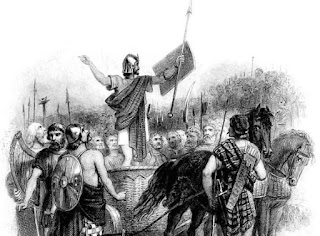The French Connection (part 1 of 3)
The Auld Alliance
Part 1
On July 12, 1503, King James IV of Scotland wrote to his new ally and future father-in-law, Henry VII of England. The English king, reflecting on the grandly named Treaty of Perpetual Peace concluded between Scotland and England the previous year, had demanded that James IV repudiate the Franco-Scottish alliance.
In his reply, the Scottish king courteously informed Henry VII that, though he had at that time no intention of renewing the Franco Scottish alliance, nevertheless 'we and our predecessors have always been accustomed to it'.
James was exaggerating, but not by much. At the outset of the 16th century, the 'Auld Alliance' had already endured for more than two centuries and would last for a further 60 years.
Why should an alliance between Scotland, a small kingdom on the northwestern fringes of Europe, and France, a major European power, endure for so long?
And why should many modern Scots, and some French, still regard the "Auld Alliance with a mixture of affection and nostalgia?
The first question is more easily answered than the second. From a Scottish standpoint, the Franco Scottish alliance was born out of dire necessity. The Scottish ruler John Balliol (whose family originated from Bailleul in Picardy) was a vassal king, owing homage and allegiance to Edward I of England.
However, the latter, a predatory ruler who would later earn himself the title "Hammer of the Scots', made John's life a misery by hearing appeals from Scotland in his own courts, and demanding military service from Scots in his projected war with France in 1294.
In this situation, a Scottish committee of 12 was appointed to put some backbone into Balliol. One of its first measures was to make an offensive and defensive alliance against England with Philip IV of France, concluded in Paris in October, 1295, and ratified by the Scots in February, 1296
In the event, the fragile and politically divided Scottish kingdom was not to be saved by the French alliance. Philip deserted his Scottish allies within a few years, and the Scots were left to resolve the major problems of finding an acceptable leader and successfully defying England in the ensuing Wars of Independence. The alliance of 1295 might have proved no more fruitful than earlier abortive treaties between Scotland and France; but the Scottish victor in the wars with England, Robert Bruce, renewed the Franco Scottish alliance in the Treaty of Corbeil (April, 1326). This was simply part of Robert's overall strategy to secure foreign recognition of his status as ruler of an independent kingdom.
But it proved timely, for three years later King Robert was dead, and in 1332, only six years after Corbeil, England's Edward III backed the Balliol cause in Scotland against Bruce's infant son David II and subjected the Scots to a bitter renewal of the Wars of Independence.
The existence of the French alliance in the 1330s proved crucial to the survival of the independent Scottish kingdom, riven as it was politically by royal succession struggles and by the intervention of Edward III, who led armies as far north as Aberdeenshire as late as a 1336. In this dangerous situation Philip VI of France provided a safe haven in Normandy for the 10-year old King David II, and his wife Joan. The young couple spent the years 1334-41 in France, mostly at the great fortress of Chateau Gaillard on the Seine. Arguably, providing asylum for David II went much further on the French side than the aid and counsel' which the treaty of Corbeil required them to give the Scots.











Comments
Post a Comment